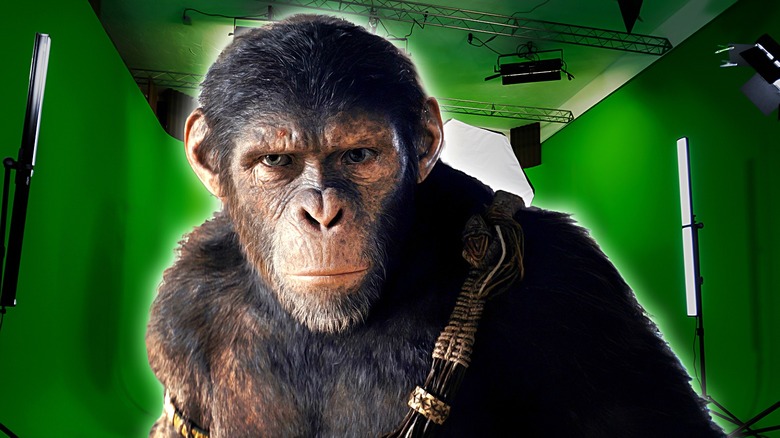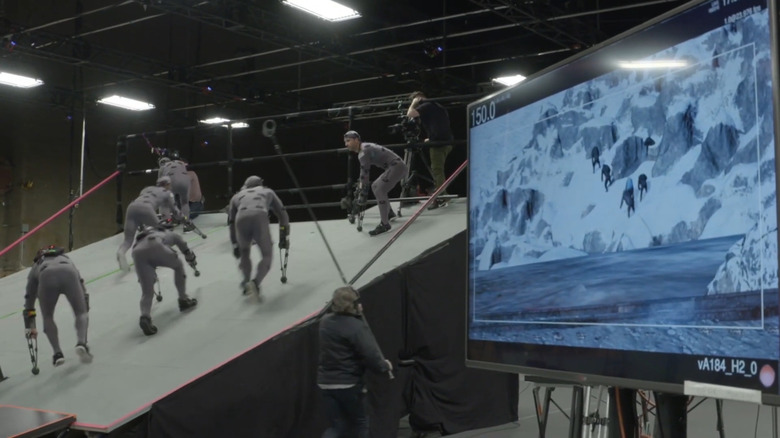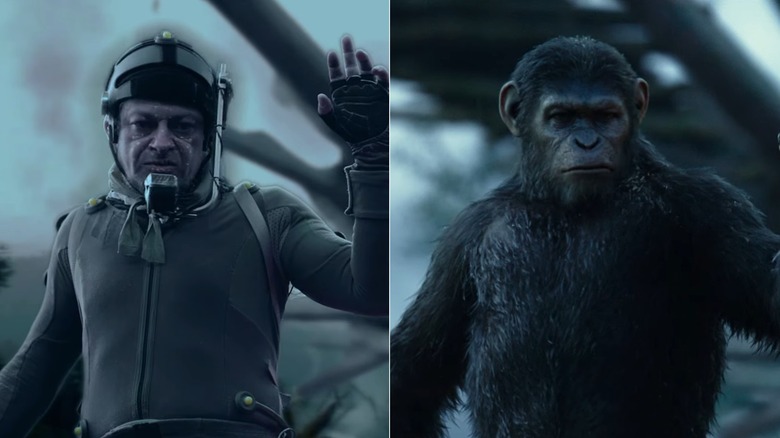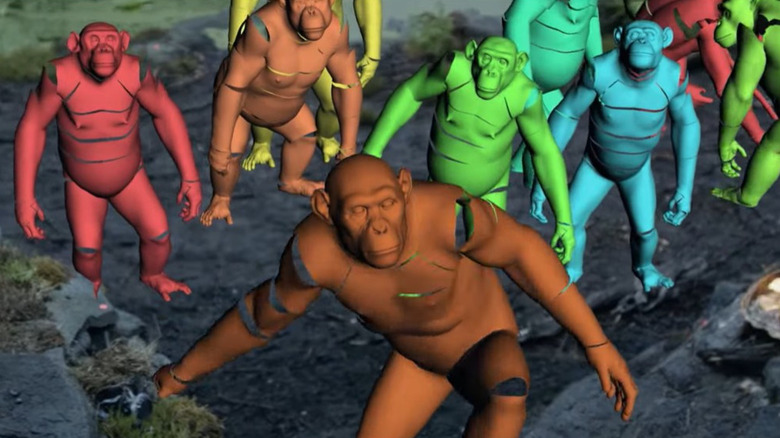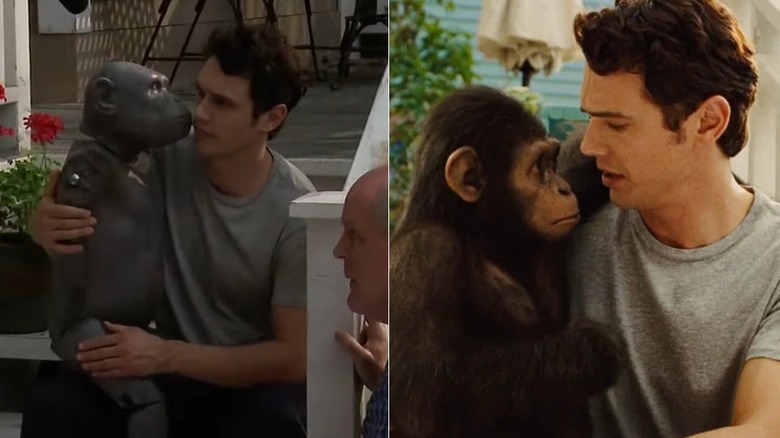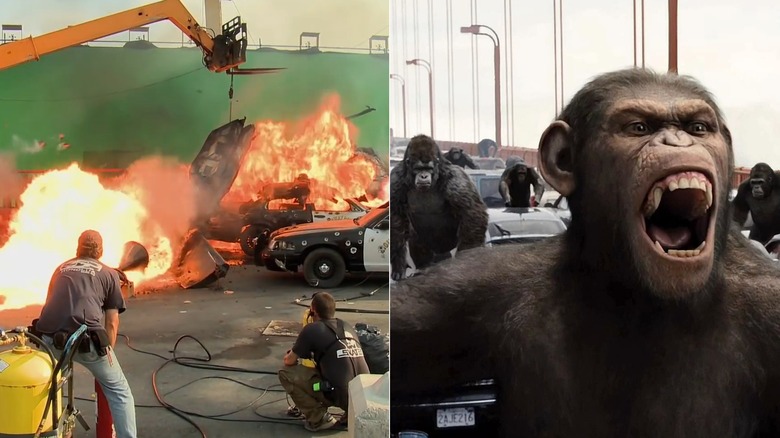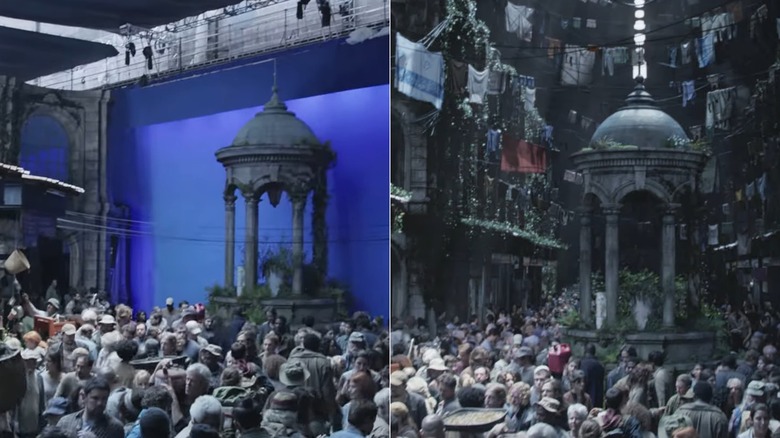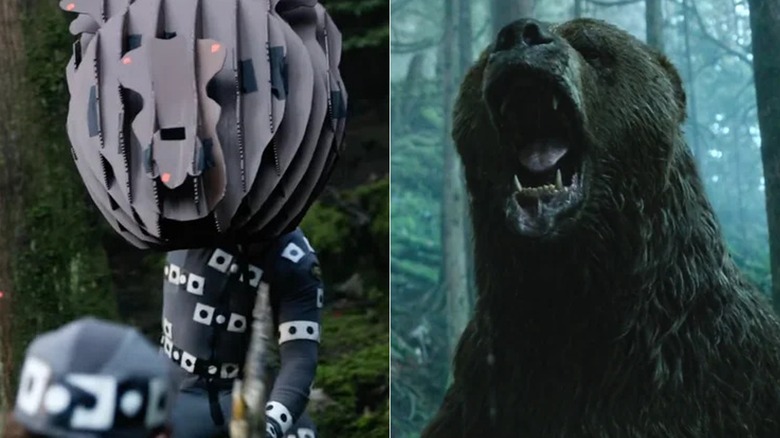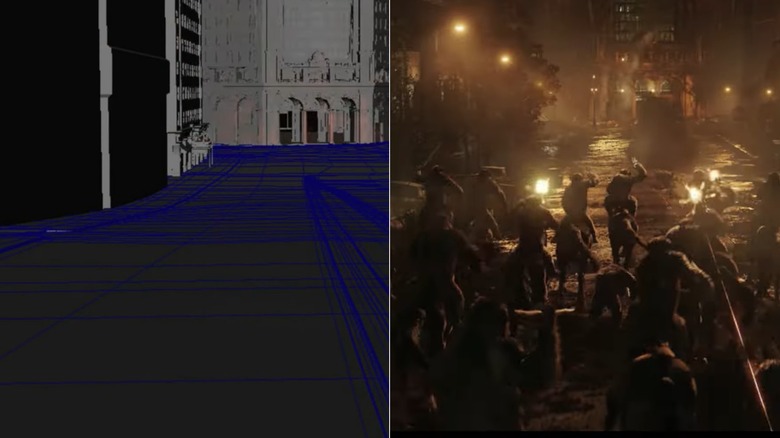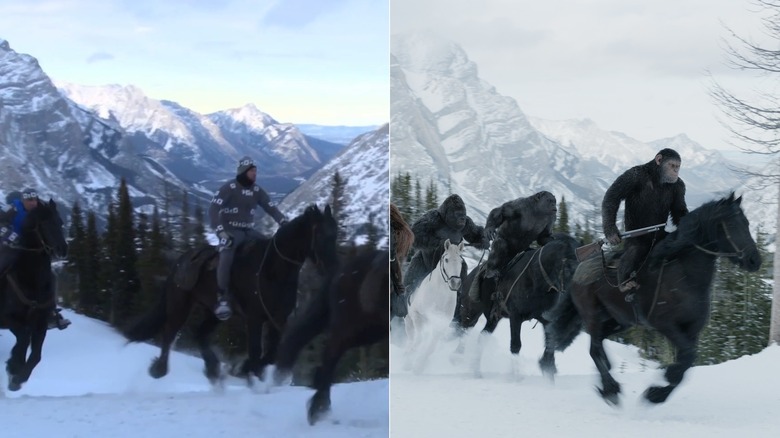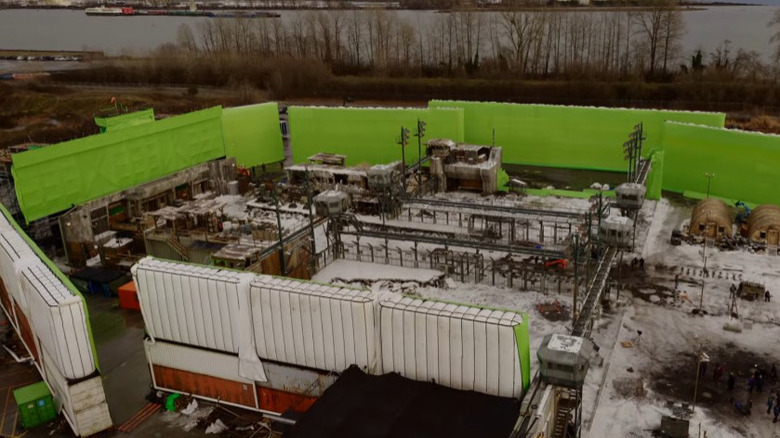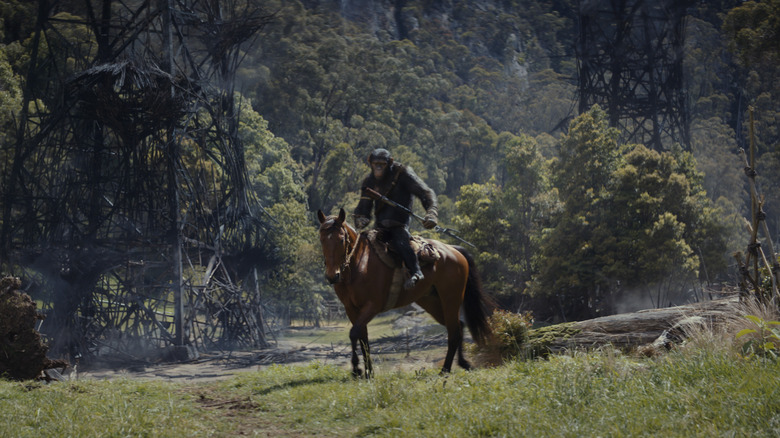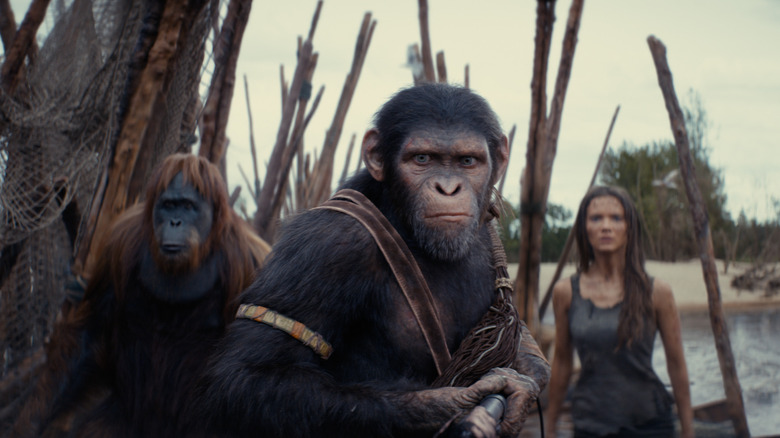What The Planet Of The Apes Franchise Looks Like Without Special Effects
The history of CGI movie characters is still relatively young, but we've already come a long way since Jar Jar Binks made his debut in "Star Wars: Episode I — The Phantom Menace." Later films, like "Avatar" and the "Lord of the Rings" trilogy, pushed the technology of performance capture to new heights, making fully animated characters more believable and human than ever. But many would argue that no franchise has been more successful at creating compelling CGI characters than "Planet of the Apes."
Ever since the series was soft-rebooted in 2011 with "Rise of the Planet of the Apes," its been a hub for some of the most advanced motion capture and special effects tech currently at work in Hollywood. Star and performance capture expert Andy Serkis took everything he learned playing Gollum and translated it into arguably his greatest role ever when he began playing Caesar. Now, with the stunning release of "Kingdom of the Planet of the Apes," the modern "Apes" franchise has continued beyond that character's story. Wes Ball's film takes major cues from the prior trilogy, especially the two Matt Reeves-directed movies, while simultaneously pushing the technological boundaries of the franchise even further.
Not everything in these movies is driven by special effects, but it's the union of powerful, grounded performances and incredible technology that makes them so unique. Without special effects, the modern "Planet of the Apes" franchise looks a whole lot different.
The actors go to ape school before filming
Before filming even starts on a "Planet of the Apes" film, the actors go through what they've often referred to as "Ape School." In essence, it's a physical theater crash course designed to acclimate the cast to the specific movements and mannerisms of real-world apes.
The footage that's been released over the years shows the various ape actors using modified crutches to effectively extend their arms, allowing them to run around on all fours in a manner similar to that of chimps or gorillas. This is often how the scenes are shot as well, as it positions the actors properly for their motion-capture data to be mapped onto the CGI ape characters.
Ape School isn't just about running around, though. Swinging, climbing, and smaller mannerisms are all part of the training as well. It's the little things — the ways the ape characters move their heads when scouting in the jungle, or how they show physical affection to one another, that elevates the films and makes the performances so believable.
Andy Serkis and other ape stars did full acting on set
If you're not that familiar with modern performance capture technology, you might wonder how much of what you see in the ape characters actually comes from the actors themselves. The truth is that mostly everything has at least its basis in the physical performance. More primitive forms of motion capture were primarily interested in body movements to map onto animated figures. These days, full performance capture is also hyper-focused on facial expressions, which is what makes the characters in the "Planet of the Apes" movies so incredibly compelling.
"You're not just standing in for the role until the magic's done later on," Andy Serkis said in a making-of featurette for "War for the Planet of the Apes." "You're not just representing the character, you are the character for real." In the same featurette, producer Rick Stafford emphasizes that the technology can only ever enhance and augment what the actors put forward. "That can't be done by just someone in a gray suit that's just doing the body movements," Stafford said. "That has to come from trained talent." While Serkis isn't in "Kingdom of the Planet of the Apes," he did work with the cast to help them develop and embrace a more complete ape physicality.
While the technology required to capture these sorts of small details is necessary for the finished product, it can also be off-putting at first for the actors wearing the gear. That's just a further testament to how professional and talented stars like Serkis, Terry Notary, Toby Kebbell, and Owen Teague really are.
The basic ape motion capture models look a lot different
The performance capture rigs used in the "Planet of the Apes" films do an impressive job of mapping physical movements and facial expressions, but the hard work of turning that data into a visually convincing character model happens later on. During production, much more rudimentary CGI models are used as placeholders for the finished products, providing a general idea of what the apes will eventually look like. Later on, it's up to the world-renowned team at Weta to turn these Nintendo 64 characters into fully-textured, properly-lit, convincing apes.
Different teams at Weta work on different parts of the ape-creation process, be it facial animations, larger body movements, or making sure that all of the CGI transposed onto the performances looks correct with all the set pieces and props involved. In order to be as accurate as possible, Weta animators have spent a lot of time studying real-life apes in zoos and other environments.
"It's fun because you're looking at these animals in another level," Weta animator Carol Madrigal said in a 2024 interview with CineMovie. "Now you see everything about them. I can't see now a chimp, or a gorilla, or an orangutan without looking at a lot more, you know, even their shoulders, like how their shoulders are moving, how they're breathing. It's really cool."
Caesar had a physical stand-in for Rise of the Planet of the Apes
The later "Planet of the Apes" movies were able to use actors for all the major ape characters while filming. However, the first of the modern series, "Rise of the Planet of the Apes," couldn't do that the whole time because of Caesar himself. For much of the movie, Caesar is a young and relatively small ape, making it impossible for Andy Serkis to play him properly until a bit later in the story. As such, co-star James Franco sometimes had to act opposite a physical puppet of sorts for the animators to map over later on.
Using physical stand-ins like this helps to make sure that the actors are always looking in the right place and orienting themselves properly around what will eventually be added in post-production. Some of young Caesar's more active scenes, in which he's shown swinging around his attic home or peering through the window that eventually becomes his symbol, were made fully with CGI.
When Weta first started working on the franchise with "Rise," the team immediately adopted a detail-first approach, modeling everything from bones to sinews in the CGI apes to create the most realistic models and movements possible.
The Golden Gate Bridge battle was shot using green screens
Throughout the modern "Planet of the Apes" franchise, a combination of location shooting, practical sets, and CGI has been used to build out the most striking set pieces. The first such sequence in the series — the Golden Gate Bridge battle and escape at the end of "Rise of the Planet of the Apes" — leaned heavier on the special effects side of things and in fact was not filmed on the iconic San Francisco landmark at all.
Instead, the production team built a large outdoor set made to mimic the bridge, complete with halted traffic, guardrails, and street lights. This set was then flanked by massive green screens so that the rest of the landscape could be added in later. As explained by actor Terry Notary, who played Rocket, in a making-of featurette, this was the first time that Weta had taken its advanced motion capture gear from "Avatar" and done a proper outdoor shoot, capturing natural lighting and full physical performances while still leaving room for the animators to fill in the gaps later on. The Golden Gate shoot set the stage in many ways for more ambitious sequences in the later movies, as well as other films like "Avatar: The Way of Water."
The human settlement in Dawn of the Planet of the Apes looked a lot different in person
Similar to the Golden Gate Bridge set in "Rise of the Planet of the Apes," the human settlement seen in the sequel, "Dawn of the Planet of the Apes," was made using a combination of CGI and practical set construction. Outside, Weta employed footage from the real San Francisco, as well as New Orleans, to set the groundwork for the film's post-apocalyptic city streets. The rest of the details, including buildings seen in the distance and the vegetation enveloping everything, was added later on.
For the interior of the human colony, a closed set was built with core set pieces and enough space to fit a mob of extras. This core area was then surrounded by blue screens and green screens to add depth and extra height to the space, giving the impression of a massive, overcrowded settlement.
The bear that attacks Blue Eyes was done via motion capture
Most of the motion capture technology in the "Planet of the Apes" movies involves the apes themselves. However, there have been times during the various productions when other creatures had to be included. One of the most notable is the bear that attacks Caesar's son Blue Eyes near the beginning of "Dawn for the Planet of the Apes." To help keep everything in order for post-production, an actor stood in for the bear without full performance capture gear, instead using a collection of physical prop pieces to simulate its presence and movement.
"Dawn" upped the ante on "Rise" immensely by taking the outdoor Golden Gate Bridge performance capture shoot and crafting a whole film around the idea. Most of the ape community's forest scenes were shot on location in Vancouver, giving the film a very distinct look from the contemporary setting of "Rise." This setting also made the technical side of filming much trickier, as the heavy rain in Vancouver had the potential to interfere with the motion-capture equipment. As a result, Weta developed new, more stable gear to ensure full performance capture in the wild.
The big battle in Dawn is mostly CGI
While a lot of "Dawn of the Planet of the Apes" was shot on location, the climactic battle in which Koba leads the apes against the human settlement is mostly CGI. The streets where the fight takes place were carefully crafted using photography and even satellite data to make sure that everything was right. However, the scene itself was digitally rendered. Since the battle takes place at night, it looks especially striking, with the darkness used to hide any glaringly obvious CGI and magnify the drama of the scene at the same time.
This kind of balance is a big part of why the modern "Apes" films look so good. The productions shoot on location when CGI simply won't cut it, but they also pick their battles for when to employ fully digital creations. As a result, the franchise mostly avoids the kind of obvious CGI callouts that you're likely to hear about similarly big-budget franchises like the Marvel Cinematic Universe. The special effects are there to augment, not replace, physical filmmaking.
War for the Planet of the Apes filmed a lot in Canada
Following in the footsteps of its predecessor, "War for the Planet of the Apes" shot extensively on location in Canada. Certain parts of the jungle fight scenes at the beginning of the film, as well as Caesar, Rocket, and Maurice's odyssey north, were filmed in the woods or in the snow, with the various horseback scenes conducted as the actors rode in full performance capture gear.
The series came a long way from the Golden Gate sequence at the end of "Rise" to the complex outdoor shoots required for "War," and the third film in the Caesar trilogy is a testament to just how far Weta was able to push its own technology while working on the franchise. However, the film still relied on sets and some moments of full CGI as well, including one truly massive location created for the film's third act.
They built the military base in War for the Planet of the Apes
One of the best things about the "Planet of the Apes" franchise is how well it realizes distinct locations, and that's certainly true of the military base where much of "War" takes place. The set itself — built in British Columbia — covered 70,000 square feet and was surrounded by 100,000 square feet of green screen to fill in the rest of the world. It was constructed outside so that filming could occur under natural light.
Since the Sierra Nevada mountains, which surround the base in the film, don't exist in British Columbia, Weta had to get creative. The studio used a technique called photogrammetry to turn footage of the actual mountain range into a digital facsimile that could stand behind and around the physical set of the army base. This same technique is how Weta constructed its overgrown San Francisco in "Dawn of the Planet of the Apes."
The trees and other living elements were added using an algorithmic tool that simulated the natural growth patterns of real forests. This attention to detail helped ensure that the snowy woods around the premises of the base looked as real as possible, especially during the mostly-CGI avalanche scene.
Most of Kingdom of the Planet of the Apes was shot in Australia
For "Kingdom of the Planet of the Apes," the team chose to switch gears from the Canadian landscapes of "War" and "Dawn." Instead, the film was shot largely on location in Australia.
"We probably had one blue screen set on the movie," director Wes Ball said in an interview with Collider. "For the most part, we're out in real locations shooting with real actors." The cast has echoed the importance of shooting on location and how much it contributed to the sense of scale. "We were on this mountainside, you know, very, very high up, but behind us was this cliff and these waterfalls," actor Owen Teague (Noa) explained to The Hook about the setting for the Eagle Clan ape village. "What you see in the movie is real, and it was stunningly beautiful."
In the same interview with Collider, however, Wes Ball confirmed that a good portion of the film's gorgeous locations were crafted digitally. "There's about 30 to 40 minutes of full CG, which I don't think people will be able to tell," the director said. "But it all started from a real camera, and a real world with real, physical actions."
A lot of the ape sets in Kingdom are real
In addition to the natural settings shown in "Kingdom," a good portion of the sets were built physically so that the actors could actually interact with them. Certain details of places like the Eagle Clan village and Proximus Caesar's encampment are heavily augmented with CGI to create a fully immersive effect, but other structures were practical sets. Proximus' throne room, where a number of core scenes take place, was constructed, as were a number of the Eagle Clan buildings.
By the end of "Kingdom of the Planet of the Apes," it's hard to tell exactly what's real and what was fabricated by Weta. As with its predecessors, the filmmakers were careful to not rely too much on the digital side of things. As a result, the world of the apes feels more alive and vibrant, and you're less likely to get distracted trying to figure out what is and isn't a practical set while watching.
